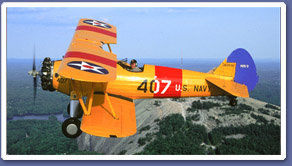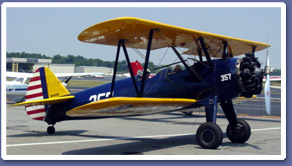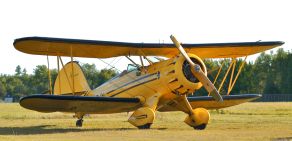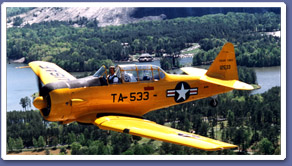|
|
 |
 |
 |
 The
Kaydet, the two-seater biplane introduced by the
Stearman Aircraft Division of Boeing in Wichita,
Kansas, in 1934, became an unexpected success during
World War II. Despite its almost obsolete
design, its simple, rugged construction made it ideal
as a trainer for novice pilots. The
Kaydet, the two-seater biplane introduced by the
Stearman Aircraft Division of Boeing in Wichita,
Kansas, in 1934, became an unexpected success during
World War II. Despite its almost obsolete
design, its simple, rugged construction made it ideal
as a trainer for novice pilots.
The Kaydets had
fabric-covered wooden wings, single-leg landing gear
and an over-built welded steel fuselage. Only
radial engines were used. Between 1936 and 1944,
Boeing built 8,585 Kaydets, in all versions, plus the
equivalent of 2,000 more in spares.
 Kaydets
were widely used airplanes. In addition to sales
to the Navy and the Army Air Corps, they were sold to
Canada, China, the Philippines, Venezuela, Argentina
and Brazil for both military and civilian uses.
Many were still in service in the early 1990's.
Their slow, low-level flying capabilities made them
particularly suitable for crop dusting and spraying. Kaydets
were widely used airplanes. In addition to sales
to the Navy and the Army Air Corps, they were sold to
Canada, China, the Philippines, Venezuela, Argentina
and Brazil for both military and civilian uses.
Many were still in service in the early 1990's.
Their slow, low-level flying capabilities made them
particularly suitable for crop dusting and spraying.
The U.S. Postal
Services features the Stearman Kaydet trainer on its
classic aircraft postage stamps.
|
| |
 |
|
 The Weaver Aircraft Company was founded in 1920 by George "Buck" Weaver, E.J. "Sam"
Junkin, and Clayton Brukner. The trade name Waco (rhymes with taco) was coined from the
title letters of Weaver Aircraft Co. Originally located in Lorain, Ohio, the company later moved
to Troy, Ohio, drawn by the concentration of aviation related businesses that had sprung up
around nearby Dayton, home of the Wright Brothers. The first Waco YMF rolled out of the Waco
factory at Troy Ohio in early 1935. In late 1942, Waco ceased production of powered airplanes. The Weaver Aircraft Company was founded in 1920 by George "Buck" Weaver, E.J. "Sam"
Junkin, and Clayton Brukner. The trade name Waco (rhymes with taco) was coined from the
title letters of Weaver Aircraft Co. Originally located in Lorain, Ohio, the company later moved
to Troy, Ohio, drawn by the concentration of aviation related businesses that had sprung up
around nearby Dayton, home of the Wright Brothers. The first Waco YMF rolled out of the Waco
factory at Troy Ohio in early 1935. In late 1942, Waco ceased production of powered airplanes.
 In 1983 the founders of Classic Aircraft Corporation envisioned their childhood dreams coming
true with the reincarnation of the Waco YMF Biplane. In the history of aviation, no company
had ever taken a fifty year old design and manufactured it new under the original FAA type
certificate. To accomplish this mission they hired experienced aeronautical engineers to re-
draw over 1400 drawings and build new tooling for production. This was done while maintaining
the sanctity of WACO.S original design. The WACO YMF is not a .rebuild. or a .kit plane., but a
brand new FAA certified production aircraft.
In 1983 the founders of Classic Aircraft Corporation envisioned their childhood dreams coming
true with the reincarnation of the Waco YMF Biplane. In the history of aviation, no company
had ever taken a fifty year old design and manufactured it new under the original FAA type
certificate. To accomplish this mission they hired experienced aeronautical engineers to re-
draw over 1400 drawings and build new tooling for production. This was done while maintaining
the sanctity of WACO.S original design. The WACO YMF is not a .rebuild. or a .kit plane., but a
brand new FAA certified production aircraft.
 The first new production WACO YMF Classic rolled off the assembly line and received FAA
certification under the original WACO type certificate in March of 1986. Today.s production
aircraft has been greeted with overwhelming enthusiasm for its craftsmanship and the sheer joy
brought to so many by making the thrill of flying in an .open-cockpit. biplane a reality. The first new production WACO YMF Classic rolled off the assembly line and received FAA
certification under the original WACO type certificate in March of 1986. Today.s production
aircraft has been greeted with overwhelming enthusiasm for its craftsmanship and the sheer joy
brought to so many by making the thrill of flying in an .open-cockpit. biplane a reality.
The first Waco UPF-7 was rolled out of the Waco factory at Troy, Ohio in June of 1937. The
UPF-7 was designed as a pilot trainer, both for primary student training and advanced training
phases, including aerobatics. 600 UPF-7s were manufactured between 1937 and late 1942.
Most were delivered to civilian flight schools participating in the Government's Civilian Pilot
Training Program (CPTP) to train thousands of civilian pilots as a backlog in case of war. The
U.S. Army Air Corps acquired 14 UPF-7s, which were designated YPT-14. The CAA (Civilian
Aeronautics Authority-predecessor to the FAA) ordered 31 UPF- 7s; these were assigned to
government inspectors to monitor civilian aviation operations.
|
|
|

|
|
|
 The North American AT-6 "Texan" is powered by a big supercharged 600 H.P. Pratt & Whitney
radial engine and was used to train future fighter pilots in the 1940's and is still raced today at
the Reno Air Races.
The North American AT-6 "Texan" is powered by a big supercharged 600 H.P. Pratt & Whitney
radial engine and was used to train future fighter pilots in the 1940's and is still raced today at
the Reno Air Races.
The T-6, a two-place advanced trainer, was the classroom for most of the Allied pilots who flew
in World War II. Called the SNJ by the Navy and the Harvard by the Royal Air Force, the T-6 was
designed as a transition trainer between basic trainers and first-line tactical aircraft.
In all, the T-6 trained several hundred thousand pilots in 34 different countries. A total of
15,495 were built. Though most famous as a trainer, the T-6 also won honors in World War II
and the early days of the Korean War.
The Texan evolved from North American Aviation's "BC-1" basic combat trainer, which was
first produced for the U.S. Army Air Corps with fixed landing gear in 1937 under a contract
that called for 174 planes. It was designed by North American Aviation as a low-cost trainer
with all the characteristics of a high-speed fighter. Although not as fast as a fighter, it was easy
to maintain and repair, had more maneuverability and was easier for a new cadet to handle.
A pilot's airplane, it could roll, immelmann, loop, spin, snap and vertical roll. It was designed
to give the best possible training in all types of tactics, from ground strafing to bombardment
and aerial dogfighting, and contained such versatile equipment as bomb racks, blind flying
instrumentation, standard cameras, both fixed and flexible guns, and just about every other
device that military pilots had to operate.
|
|

|
|
|
|
|